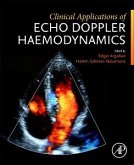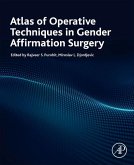Clinical Atlas of Gonioscopy
Herausgeber: Qiao, Chunyan; Liu, Mugen; Wang, Qianqian; Huang, Ping
Clinical Atlas of Gonioscopy
Herausgeber: Qiao, Chunyan; Liu, Mugen; Wang, Qianqian; Huang, Ping
- Broschiertes Buch
- Merkliste
- Auf die Merkliste
- Bewerten Bewerten
- Teilen
- Produkt teilen
- Produkterinnerung
- Produkterinnerung
Clinical Atlas of Gonioscopy comprehensively and systematically covers all aspects of gonioscopy: from basic knowledge and common manifestations to characteristic signs of different diseases, and the application of gonioscopy in the laser and surgical treatment of glaucoma. Including over a thousand high-quality images, it helps clinicians explore the diverse and fascinating world of the anterior chamber angle, and deepens their understanding of the pathogenesis, classification, diagnosis, differential diagnosis, treatment and follow-ups of glaucoma.
Andere Kunden interessierten sich auch für
![Clinical Applications of Echo Doppler Haemodynamics Clinical Applications of Echo Doppler Haemodynamics]() Clinical Applications of Echo Doppler Haemodynamics159,99 €
Clinical Applications of Echo Doppler Haemodynamics159,99 €![Research and Clinical Applications of Targeting Gastric Neoplasms Research and Clinical Applications of Targeting Gastric Neoplasms]() Research and Clinical Applications of Targeting Gastric Neoplasms145,99 €
Research and Clinical Applications of Targeting Gastric Neoplasms145,99 €![How Sex and Gender Impact Clinical Practice How Sex and Gender Impact Clinical Practice]() How Sex and Gender Impact Clinical Practice135,99 €
How Sex and Gender Impact Clinical Practice135,99 €![Clinical Applications of Noncoding Rnas in Cancer Clinical Applications of Noncoding Rnas in Cancer]() Clinical Applications of Noncoding Rnas in Cancer163,99 €
Clinical Applications of Noncoding Rnas in Cancer163,99 €![Liquid Biopsy in Urogenital Cancers and Its Clinical Utility Liquid Biopsy in Urogenital Cancers and Its Clinical Utility]() Liquid Biopsy in Urogenital Cancers and Its Clinical Utility149,99 €
Liquid Biopsy in Urogenital Cancers and Its Clinical Utility149,99 €![Toxicology Cases for the Clinical and Forensic Laboratory Toxicology Cases for the Clinical and Forensic Laboratory]() Toxicology Cases for the Clinical and Forensic Laboratory111,99 €
Toxicology Cases for the Clinical and Forensic Laboratory111,99 €![Atlas of Operative Techniques in Gender Affirmation Surgery Atlas of Operative Techniques in Gender Affirmation Surgery]() Atlas of Operative Techniques in Gender Affirmation Surgery149,99 €
Atlas of Operative Techniques in Gender Affirmation Surgery149,99 €-
-
-
Clinical Atlas of Gonioscopy comprehensively and systematically covers all aspects of gonioscopy: from basic knowledge and common manifestations to characteristic signs of different diseases, and the application of gonioscopy in the laser and surgical treatment of glaucoma. Including over a thousand high-quality images, it helps clinicians explore the diverse and fascinating world of the anterior chamber angle, and deepens their understanding of the pathogenesis, classification, diagnosis, differential diagnosis, treatment and follow-ups of glaucoma.
Produktdetails
- Produktdetails
- Verlag: Elsevier Science
- Seitenzahl: 300
- Erscheinungstermin: 1. Januar 2026
- Englisch
- ISBN-13: 9780443440397
- ISBN-10: 0443440395
- Artikelnr.: 74313191
- Herstellerkennzeichnung
- Libri GmbH
- Europaallee 1
- 36244 Bad Hersfeld
- gpsr@libri.de
- Verlag: Elsevier Science
- Seitenzahl: 300
- Erscheinungstermin: 1. Januar 2026
- Englisch
- ISBN-13: 9780443440397
- ISBN-10: 0443440395
- Artikelnr.: 74313191
- Herstellerkennzeichnung
- Libri GmbH
- Europaallee 1
- 36244 Bad Hersfeld
- gpsr@libri.de
Chapter 1 Basics of Gonioscopy
Section I History and Evolution of the Gonioscopy
1. Overview of Gonioscopy
2. History of Gonioscopy
3. Anterior Chamber Angle Imaging Technology
Section II Embryology of the Anterior Chamber Angle
Section III Anatomy of the Anterior Chamber Angle
1. Schwalbe’s Line
2. Trabecular Meshwork and Schlemm’s Canal
3. Scleral Spur
4. Ciliary Body Band
5. Iris Root
6. Iris Processes (Ligameata Pectinatum Iridis)
Section IV How to Choose Appropriate Gonioscopic Lenses
1. Direct Gonioscopy Lenses
2. Indirect Gonioscopy Lenses
3. Intraoperative Gonioscopy Lenses
4. Therapeutic Gonioscopy Lenses
5. Digital Gonioscopy Lenses
6. Summary of Commonly Used Gonioscopy Lenses
Section V Indications, Contraindications and Limitation of Gonioscopy
Section VI Techniques of Gonioscopy
Section VII Gonioscopy Grading Systems
1. The Scheie Classification
2. The Shaffer Classification
3. The Spaeth Classification
Section VIII Documentation of Gonioscopy Findings
Section IX Other Clinical Uses of Gonioscopy Lenses
Section X Cleaning, Disinfection and Sterilization of Gonioscopy Lenses
1. Manual Cleaning
2. Germicidal Disinfection
3. High-Pressure Steam and Dry-Heat Sterilization
4. Sterilization after Use in Patients with Infectious Diseases
Section XI Steps and Techniques of Gonioscopic Angle Imaging
1. Steps of Gonioscopic Imaging
2. Techniques of Gonioscopic Imaging
Chapter 2 Common Abnormal Findings on Gonioscopy
Section I Peripheral Anterior Synechiae
Section II Angle Hyperpigmentation
Section III Neovascularization of the Angle
Section IV Silicone Oil in the Angle
Section V Tumors and Foreign Bodies of the Angle
Chapter 3 Gonioscopic Findings of Different Ophthalmic Diseases
Section I Primary Open-Angle Glaucoma
Section II Primary Angle-Closure Glaucoma
Section III Secondary Glaucoma
1. Pigment Dispersion Syndrome and Pigmentary Glaucoma
2. Neovascular Glaucoma
3. Traumatic Glaucoma
4. Iridocorneal Endothelial (ICE) Syndrome
5. Uveitic Glaucoma
6. Pseudoexfoliative Glaucoma
7. Glaucoma secondary to intraocular surgery
8. Iridoschisis
Section IV Childhood Glaucoma
1. Primary Congenital Glaucoma
2. Axenfeld-Rieger Syndrome
3. Aniridia
4. Ectropion Uvea
5. Sturge-Weber Syndrome
6. Phakomatosis Pigmentovascularis
7. Neurofibromatosis Type I
8. Oculocerebrorenal Syndrome (Lowe Syndrome)
9. Stickler Syndrome
10. Alagille Syndrome Chapter 4 The Use of Gonioscopy Lenses in Glaucoma
Treatments
Section I Use of Gonioscopy Lenses in Laser Treatments
Section II Use of Gonioscopy Lenses in Surgical Treatments
Section III Gonioscopic Findings Before and After Glaucoma Surgeries
Section I History and Evolution of the Gonioscopy
1. Overview of Gonioscopy
2. History of Gonioscopy
3. Anterior Chamber Angle Imaging Technology
Section II Embryology of the Anterior Chamber Angle
Section III Anatomy of the Anterior Chamber Angle
1. Schwalbe’s Line
2. Trabecular Meshwork and Schlemm’s Canal
3. Scleral Spur
4. Ciliary Body Band
5. Iris Root
6. Iris Processes (Ligameata Pectinatum Iridis)
Section IV How to Choose Appropriate Gonioscopic Lenses
1. Direct Gonioscopy Lenses
2. Indirect Gonioscopy Lenses
3. Intraoperative Gonioscopy Lenses
4. Therapeutic Gonioscopy Lenses
5. Digital Gonioscopy Lenses
6. Summary of Commonly Used Gonioscopy Lenses
Section V Indications, Contraindications and Limitation of Gonioscopy
Section VI Techniques of Gonioscopy
Section VII Gonioscopy Grading Systems
1. The Scheie Classification
2. The Shaffer Classification
3. The Spaeth Classification
Section VIII Documentation of Gonioscopy Findings
Section IX Other Clinical Uses of Gonioscopy Lenses
Section X Cleaning, Disinfection and Sterilization of Gonioscopy Lenses
1. Manual Cleaning
2. Germicidal Disinfection
3. High-Pressure Steam and Dry-Heat Sterilization
4. Sterilization after Use in Patients with Infectious Diseases
Section XI Steps and Techniques of Gonioscopic Angle Imaging
1. Steps of Gonioscopic Imaging
2. Techniques of Gonioscopic Imaging
Chapter 2 Common Abnormal Findings on Gonioscopy
Section I Peripheral Anterior Synechiae
Section II Angle Hyperpigmentation
Section III Neovascularization of the Angle
Section IV Silicone Oil in the Angle
Section V Tumors and Foreign Bodies of the Angle
Chapter 3 Gonioscopic Findings of Different Ophthalmic Diseases
Section I Primary Open-Angle Glaucoma
Section II Primary Angle-Closure Glaucoma
Section III Secondary Glaucoma
1. Pigment Dispersion Syndrome and Pigmentary Glaucoma
2. Neovascular Glaucoma
3. Traumatic Glaucoma
4. Iridocorneal Endothelial (ICE) Syndrome
5. Uveitic Glaucoma
6. Pseudoexfoliative Glaucoma
7. Glaucoma secondary to intraocular surgery
8. Iridoschisis
Section IV Childhood Glaucoma
1. Primary Congenital Glaucoma
2. Axenfeld-Rieger Syndrome
3. Aniridia
4. Ectropion Uvea
5. Sturge-Weber Syndrome
6. Phakomatosis Pigmentovascularis
7. Neurofibromatosis Type I
8. Oculocerebrorenal Syndrome (Lowe Syndrome)
9. Stickler Syndrome
10. Alagille Syndrome Chapter 4 The Use of Gonioscopy Lenses in Glaucoma
Treatments
Section I Use of Gonioscopy Lenses in Laser Treatments
Section II Use of Gonioscopy Lenses in Surgical Treatments
Section III Gonioscopic Findings Before and After Glaucoma Surgeries
Chapter 1 Basics of Gonioscopy
Section I History and Evolution of the Gonioscopy
1. Overview of Gonioscopy
2. History of Gonioscopy
3. Anterior Chamber Angle Imaging Technology
Section II Embryology of the Anterior Chamber Angle
Section III Anatomy of the Anterior Chamber Angle
1. Schwalbe’s Line
2. Trabecular Meshwork and Schlemm’s Canal
3. Scleral Spur
4. Ciliary Body Band
5. Iris Root
6. Iris Processes (Ligameata Pectinatum Iridis)
Section IV How to Choose Appropriate Gonioscopic Lenses
1. Direct Gonioscopy Lenses
2. Indirect Gonioscopy Lenses
3. Intraoperative Gonioscopy Lenses
4. Therapeutic Gonioscopy Lenses
5. Digital Gonioscopy Lenses
6. Summary of Commonly Used Gonioscopy Lenses
Section V Indications, Contraindications and Limitation of Gonioscopy
Section VI Techniques of Gonioscopy
Section VII Gonioscopy Grading Systems
1. The Scheie Classification
2. The Shaffer Classification
3. The Spaeth Classification
Section VIII Documentation of Gonioscopy Findings
Section IX Other Clinical Uses of Gonioscopy Lenses
Section X Cleaning, Disinfection and Sterilization of Gonioscopy Lenses
1. Manual Cleaning
2. Germicidal Disinfection
3. High-Pressure Steam and Dry-Heat Sterilization
4. Sterilization after Use in Patients with Infectious Diseases
Section XI Steps and Techniques of Gonioscopic Angle Imaging
1. Steps of Gonioscopic Imaging
2. Techniques of Gonioscopic Imaging
Chapter 2 Common Abnormal Findings on Gonioscopy
Section I Peripheral Anterior Synechiae
Section II Angle Hyperpigmentation
Section III Neovascularization of the Angle
Section IV Silicone Oil in the Angle
Section V Tumors and Foreign Bodies of the Angle
Chapter 3 Gonioscopic Findings of Different Ophthalmic Diseases
Section I Primary Open-Angle Glaucoma
Section II Primary Angle-Closure Glaucoma
Section III Secondary Glaucoma
1. Pigment Dispersion Syndrome and Pigmentary Glaucoma
2. Neovascular Glaucoma
3. Traumatic Glaucoma
4. Iridocorneal Endothelial (ICE) Syndrome
5. Uveitic Glaucoma
6. Pseudoexfoliative Glaucoma
7. Glaucoma secondary to intraocular surgery
8. Iridoschisis
Section IV Childhood Glaucoma
1. Primary Congenital Glaucoma
2. Axenfeld-Rieger Syndrome
3. Aniridia
4. Ectropion Uvea
5. Sturge-Weber Syndrome
6. Phakomatosis Pigmentovascularis
7. Neurofibromatosis Type I
8. Oculocerebrorenal Syndrome (Lowe Syndrome)
9. Stickler Syndrome
10. Alagille Syndrome Chapter 4 The Use of Gonioscopy Lenses in Glaucoma
Treatments
Section I Use of Gonioscopy Lenses in Laser Treatments
Section II Use of Gonioscopy Lenses in Surgical Treatments
Section III Gonioscopic Findings Before and After Glaucoma Surgeries
Section I History and Evolution of the Gonioscopy
1. Overview of Gonioscopy
2. History of Gonioscopy
3. Anterior Chamber Angle Imaging Technology
Section II Embryology of the Anterior Chamber Angle
Section III Anatomy of the Anterior Chamber Angle
1. Schwalbe’s Line
2. Trabecular Meshwork and Schlemm’s Canal
3. Scleral Spur
4. Ciliary Body Band
5. Iris Root
6. Iris Processes (Ligameata Pectinatum Iridis)
Section IV How to Choose Appropriate Gonioscopic Lenses
1. Direct Gonioscopy Lenses
2. Indirect Gonioscopy Lenses
3. Intraoperative Gonioscopy Lenses
4. Therapeutic Gonioscopy Lenses
5. Digital Gonioscopy Lenses
6. Summary of Commonly Used Gonioscopy Lenses
Section V Indications, Contraindications and Limitation of Gonioscopy
Section VI Techniques of Gonioscopy
Section VII Gonioscopy Grading Systems
1. The Scheie Classification
2. The Shaffer Classification
3. The Spaeth Classification
Section VIII Documentation of Gonioscopy Findings
Section IX Other Clinical Uses of Gonioscopy Lenses
Section X Cleaning, Disinfection and Sterilization of Gonioscopy Lenses
1. Manual Cleaning
2. Germicidal Disinfection
3. High-Pressure Steam and Dry-Heat Sterilization
4. Sterilization after Use in Patients with Infectious Diseases
Section XI Steps and Techniques of Gonioscopic Angle Imaging
1. Steps of Gonioscopic Imaging
2. Techniques of Gonioscopic Imaging
Chapter 2 Common Abnormal Findings on Gonioscopy
Section I Peripheral Anterior Synechiae
Section II Angle Hyperpigmentation
Section III Neovascularization of the Angle
Section IV Silicone Oil in the Angle
Section V Tumors and Foreign Bodies of the Angle
Chapter 3 Gonioscopic Findings of Different Ophthalmic Diseases
Section I Primary Open-Angle Glaucoma
Section II Primary Angle-Closure Glaucoma
Section III Secondary Glaucoma
1. Pigment Dispersion Syndrome and Pigmentary Glaucoma
2. Neovascular Glaucoma
3. Traumatic Glaucoma
4. Iridocorneal Endothelial (ICE) Syndrome
5. Uveitic Glaucoma
6. Pseudoexfoliative Glaucoma
7. Glaucoma secondary to intraocular surgery
8. Iridoschisis
Section IV Childhood Glaucoma
1. Primary Congenital Glaucoma
2. Axenfeld-Rieger Syndrome
3. Aniridia
4. Ectropion Uvea
5. Sturge-Weber Syndrome
6. Phakomatosis Pigmentovascularis
7. Neurofibromatosis Type I
8. Oculocerebrorenal Syndrome (Lowe Syndrome)
9. Stickler Syndrome
10. Alagille Syndrome Chapter 4 The Use of Gonioscopy Lenses in Glaucoma
Treatments
Section I Use of Gonioscopy Lenses in Laser Treatments
Section II Use of Gonioscopy Lenses in Surgical Treatments
Section III Gonioscopic Findings Before and After Glaucoma Surgeries








